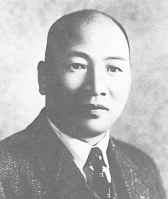 Shizuoka Profiles:
Shizuoka Profiles:
Born in 1897 in the fishing village of Yui-cho in Shizuoka prefecture, Isokichi was the third son of a local fisherman. After elementary school, he apprenticed to a wealthy fish monger in Kofu City. Establishing a reputation for hard work and dependability, Isokichi seemed likely to succeed in the seafood sales business.
In 1918 the young Goto was conscripted into the Imperial Army. After serving a brief time in Manchuria, he was promoted to corporal. Even after his tour of duty, Isokichi maintained close links with many army comrades. Like many people of his time, believed it was Japan's destiny to expand and "help" other countries in Asia.
In 1922 a marriage was arranged between Isokichi and Kiyoshiko Goto, the eldest daughter of a wealthy Shimizu fish merchant. Adopted into this family, Isokichi became active in the family enterprise. The following year a daughter was born.
Keen on mechanizing the seafood industry, in 1929 Isokichi spent several months at a canning facility in Chiba. The following year he made a trip to the United States to learn more about seafood processing. Soon after his return, he opened a tuna processing factory in Shizuoka with technical aid from Murakami Yoshio. This soon expanded to include fruit processing.
When the economic depression of the 1930s set in, Isokichi faced high overseas tariffs. Trade friction between Japan and the United States was mounting. Later in the decade when international sales of seafood plummeted, domestic demand - particularly from the armed forces - rose.
In 1935 a factory was set up in Yaizu and Isokichi became the director of Tokai Mitsui Consolidated Canners. Two years later he became general director of that company. One reason for his success was his ability to work well with a wide range of business leaders. Another was his indefatigable energy.
In 1942 the Goto Canning Company was subsumed into the Shizuoka Canning Company and placed under military control. Special large containers of canned seafood products were prepared for Japanese troops at the Shizuoka and Yaizu factories.
During much of 1943 Isokichi inspected Japanese canning facilities in China. The following year he became chair of Shimizu's Civil Defense Corps. His primary goal was to reduce the devastation caused by American bombing raids. Shizuoka was bombed ten times during World War II and by the end of the war, most industrial parts of the city were in shambles. With no funds to resume canning operations, Isokichi devoted his final months to helping the local community recover as best as it could.
He also started a small scale taxi company which flourished for a period.
On January 19, 1946 he died of a brain hemorrhage. The governor of Shizuoka prefecture, mayor of Shimizu, and many others attended his funeral. Today Isokichi rests at Honnouji temple in Shizuoka and Hagoromo Foods is now a company with about 800 employees and a net sales of over seventy million yen oer year.